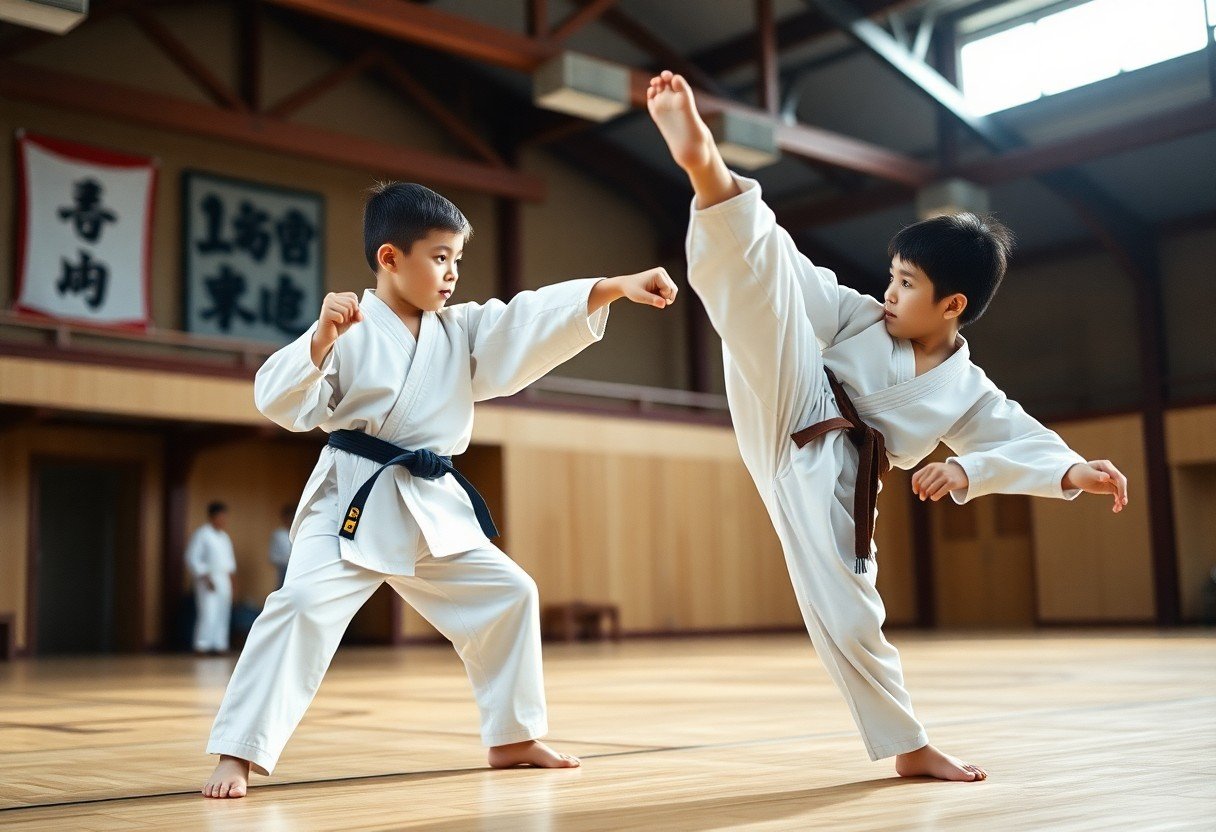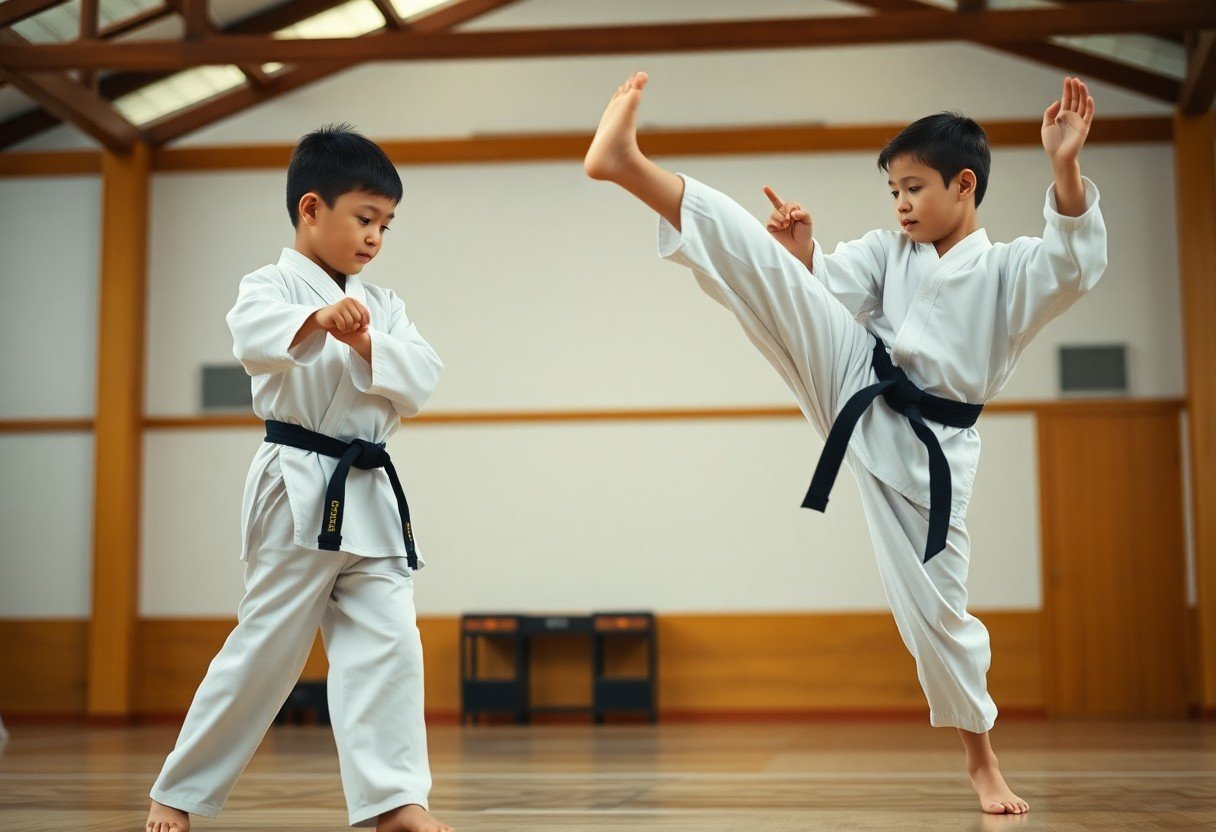Karate offers discipline, respect, and physical fitness that can greatly benefit your child. However, Taekwondo, with its focus on fast-paced kicks and agility, may better suit those who enjoy dynamic movement. When deciding between these martial arts, it’s important to consider your child’s interests, fitness level, and goals. This guide will help you weigh the pros and cons of each discipline to determine which art aligns best with your child’s needs and aspirations.
Overview of Karate
A martial art that originated in Japan, Karate focuses on striking techniques such as punching, kicking, knee strikes, and elbow strikes. It combines physical fitness with mental discipline, making it an excellent choice for your child’s development. Through training, children not only learn self-defence skills but also develop confidence, respect, and perseverance, which are vital life skills.
History and Origins
With roots tracing back to the Ryukyu Kingdom in the 19th century, Karate emerged from the fusion of indigenous Okinawan fighting styles and Chinese martial arts. The method was introduced to Japan in the early 20th century, rapidly gaining popularity and evolving into various styles, making it a widely practised form of martial arts today.
Key Techniques and Styles
Across the diverse landscape of Karate, you will find various techniques and styles, each with unique characteristics. The most common include Shotokan, recognised for its powerful linear movements, and Goju-Ryu, which emphasises a mix of hard and soft techniques. Other styles, such as Shito-Ryu and Wado-Ryu, further highlight the discipline’s adaptability and richness. Each style provides your child with opportunities to learn not only combat techniques but also vital principles like balance and control.
This diversity in styles means that your child can explore different elements of Karate, from kata (forms) that enhance their technique to kumite (sparring) which develops practical application. As students progress in their training, they will also be taught the importance of discipline and respect, both crucial for their growth as martial artists and individuals. Ultimately, Karate offers your child a dynamic and engaging way to develop physical and mental resilience.
Overview of Taekwondo
While Taekwondo is a dynamic martial art, known for its high-energy kicking techniques and agile movements, it also promotes discipline, respect, and self-confidence in children. This sport not only develops physical fitness but also supports mental well-being, making it a well-rounded choice for young practitioners. The combination of sport and art enhances your child’s focus and determination while providing them with valuable self-defence skills.
History and Origins
For centuries, Taekwondo has evolved from ancient Korean martial arts, with roots tracing back to the early kingdoms of Korea. It became formalised in the mid-20th century, blending traditional Korean fighting styles with influences from Japanese and Chinese martial arts. As it gained popularity, Taekwondo developed into a global phenomenon, celebrated for its unique techniques and competitive sport.
Key Techniques and Styles
Before delving into the specifics of Taekwondo’s techniques, you’ll find that it primarily focuses on kicking, punching, blocking, and self-defence. There are various styles within Taekwondo, including Olympic Taekwondo, which emphasises sparring, while traditional practices often focus on forms (Hyung) and self-discipline.
Consequently, in Taekwondo, kicks remain the standout feature, with styles like the axe kick, roundhouse kick, and side kick prominently showcased. Each technique is aimed at developing agility and precision, ensuring that your child learns effective self-defence moves. The focus on spinning, jumping, and dynamic kicks sets Taekwondo apart from other martial arts, engaging your child in exciting physical activity while instilling a sense of accomplishment and progress.
Benefits of Karate for Kids
There’s no denying that Karate Vs. Taekwondo for Kids offers numerous advantages for your child. Engaging in karate can significantly improve their physical fitness, enhance coordination, and boost flexibility. This martial art not only helps develop their strength but also promotes a sense of discipline and respect, which are integral values in karate. As your child progresses, they build self-confidence and learn valuable skills that extend beyond the dojo.
Physical Benefits
After enrolling your child in karate, you’ll notice improvements in their physical health. Regular practice enhances cardiovascular fitness, strengthens muscles, and improves overall body coordination. The dynamic movements and techniques involved in karate encourage your child to develop better balance and agility, contributing to their physical prowess in sports and daily activities.
Mental and Emotional Benefits
Against a backdrop of high-stress environments, karate provides your child with vital mental and emotional benefits. It fosters focus, discipline, and resilience, which are vital in navigating challenges both within and outside the dojo. Karate training involves setting and achieving goals, thereby cultivating a sense of achievement and boosting self-esteem.
To maximise the mental and emotional advantages of karate, your child learns to channel their energy and emotions effectively. This martial art teaches them how to manage stress and frustration through meditation and mindfulness techniques. Additionally, the strong sense of community and camaraderie found in karate classes often enhances their social skills and provides them with a network of supportive peers, promoting a positive self-image and reducing feelings of isolation.
Benefits of Taekwondo for Kids
Not only does Taekwondo provide a fun way for your child to learn self-defence, but it also promotes discipline and respect. Children engaged in this martial art often demonstrate improved focus and increased physical fitness, making it an excellent choice for enhancing their overall well-being.
Physical Benefits
Across various age groups, children practising Taekwondo develop strength, flexibility, and coordination. The varied movements involved in the sport work different muscle groups, contributing to better overall fitness. Regular practice also helps to improve cardiovascular health and encourages an active lifestyle.
Mental and Emotional Benefits
Alongside physical improvements, Taekwondo plays a significant role in shaping your child’s mental and emotional well-being. Engaging in structured practice helps enhance their concentration and memory, enabling them to excel academically and socially.
This practice encourages your child to set and achieve goals, fostering a sense of accomplishment. As they progress through the ranks, the experience can boost their self-confidence and resilience, important for tackling challenges in life. Moreover, participating in Taekwondo helps develop respect towards instructors and peers, nurturing a strong sense of community and empathy that can carry into other areas of their life.

Comparing Karate and Taekwondo
Keep in mind that while Karate and Taekwondo share similarities as martial arts, they also have distinct differences. Below is a comparison to help you make an informed decision:
| Karate | Taekwondo |
|---|---|
| Focuses on hand techniques alongside kicks | Emphasises high, fast kicks |
| Developed in Japan, with various styles | Originated from Korea with a standardised approach |
| Training promotes discipline and self-control | Training encourages agility and flexibility |
Training Methods and Philosophy
Against the principles of sport, Karate typically focuses on self-defence and discipline, incorporating kata (forms) and kihon (basics). In contrast, Taekwondo places greater emphasis on sparring and techniques, promoting agility and dynamic movements. Both arts instil respect and perseverance, but their methods and philosophies cater to different preferences and goals in your child’s martial arts journey.
Competition and Sparring
The competitive landscape of Karate and Taekwondo showcases different sparring styles and rules. Karate competitions often prioritise points scored through precise techniques, whereas Taekwondo tends to focus on the number of successful kicks and controlling the opponent.
To engage effectively in competition, your child will need to adapt to the unique sparing rules of each martial art. In Karate, point scoring is based on controlled strikes, encouraging precision and focus, whilst Taekwondo’s competition often rewards speed and high-level kicks. Safety gear is crucial in both styles to minimise risk. Ultimately, the choice should align with your child’s preferences and what they hope to achieve in the world of martial arts.
Choosing the Right Martial Art for Your Child
Many parents find themselves pondering the best martial art for their child. When deciding between styles like Karate and Taekwondo, consider your child’s interests, physical abilities, and goals. Each discipline offers unique benefits and challenges. For a deeper comparison, explore Karate vs. Taekwondo vs. Judo for Kids: The Best Choice to guide your choice.
Considerations for Parents
Among the factors you should weigh are your child’s personality, the style’s philosophy, and class availability. Understanding the values taught in each martial art can help align with your family’s beliefs and your child’s needs.
Finding the Right Dojo
About choosing a dojo, it’s necessary to visit several to get a feel for the environment. Look for a place that promotes positive behaviour, safety, and respect among students and instructors. Your child’s comfort level is important as they will be more likely to engage and excel in their practice.
And when searching for the right dojo, ensure you observe classes and ask about the instructor’s qualifications and teaching style. Look for places that foster a supportive atmosphere and have a solid reputation for safety and discipline. Choosing a dojo that prioritises respect allows your child to thrive while learning valuable self-defence techniques.
Final Words
Upon reflecting on the comparison between Karate and Taekwondo for your child, it’s vital to consider their interests and physical attributes. Karate offers a blend of self-defence techniques and forms, while Taekwondo emphasises striking and agility. Each martial art provides unique benefits, such as discipline, respect, and physical fitness. Ultimately, the best choice depends on what resonates with your child’s personality and goals. By assessing these factors, you can confidently guide them towards the martial art that enhances their development and enjoyment.
FAQ
Q: What are the main differences between Karate and Taekwondo?
A: The primary differences between Karate and Taekwondo lie in their techniques and philosophies. Karate, which originated from Japan, focuses on hand techniques, strikes, and kata (forms). It emphasises a balanced approach to both striking and defensive techniques. In contrast, Taekwondo, which hails from Korea, prioritises high, fast kicks and dynamic movements. It is also characterised by its emphasis on sparring and competition, with a strong focus on kicking techniques.
Q: Which martial art offers better physical fitness benefits for children?
A: Both Karate and Taekwondo provide significant physical fitness benefits for children, including improved strength, flexibility, and coordination. However, Taekwondo is often regarded as more physically demanding due to its high-intensity kicking techniques, which enhance cardiovascular fitness. Alternatively, Karate also promotes overall fitness through diverse techniques that incorporate both upper and lower body movements. The choice may depend on your child’s fitness goals and interests.
Q: How can I decide which martial art is more suitable for my child?
A: When deciding between Karate and Taekwondo for your child, consider their personality, interests, and physical abilities. If your child prefers a focus on tradition, discipline, and hand techniques, Karate might be the better option. Conversely, if they enjoy high-energy activities and kicking, Taekwondo could be more appealing. It might be beneficial for your child to try classes in both disciplines to see which one resonates more with them.
Q: Are there any age restrictions for children to start learning Karate or Taekwondo?
A: Most martial arts schools offer classes for children as young as three or four years old. Both Karate and Taekwondo have programmes specifically designed for young beginners, focusing on basic techniques, coordination, and self-discipline. It is advisable to check with individual schools, as age requirements may vary depending on the dojo or dojang and the structure of their classes.
Q: What are the benefits of enrolling my child in a martial arts class?
A: Enrolling your child in a martial arts class, whether it be Karate or Taekwondo, can offer numerous benefits. These include improved self-esteem, enhanced focus and concentration, better physical fitness, and the development of self-defence skills. Additionally, martial arts classes promote respect, discipline, and teamwork, providing children with valuable life skills and instilling a sense of achievement as they progress through ranks and earn belts.



